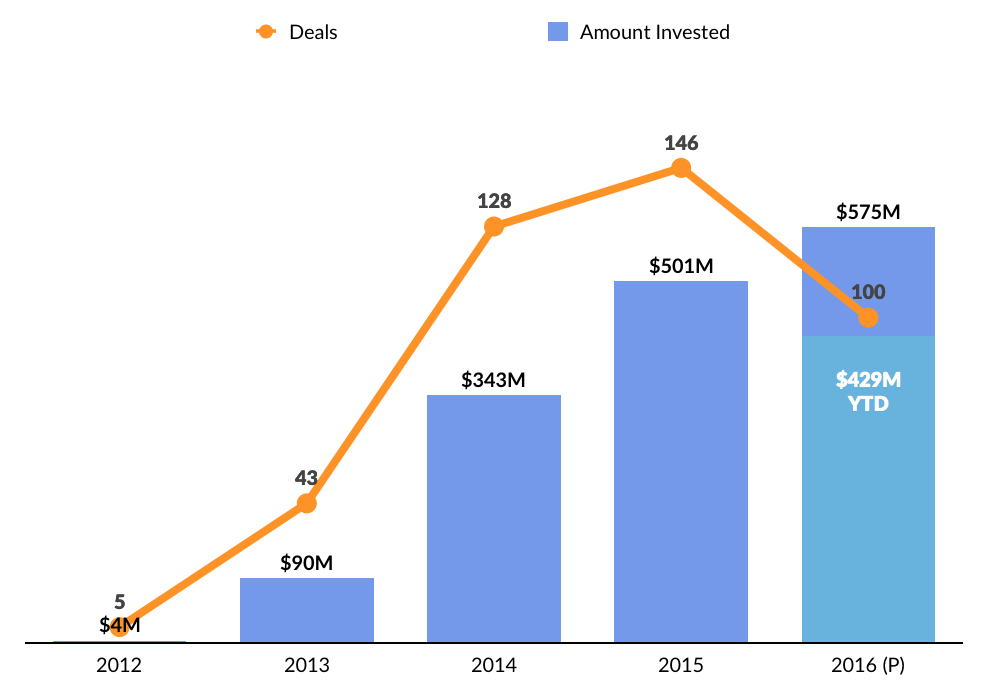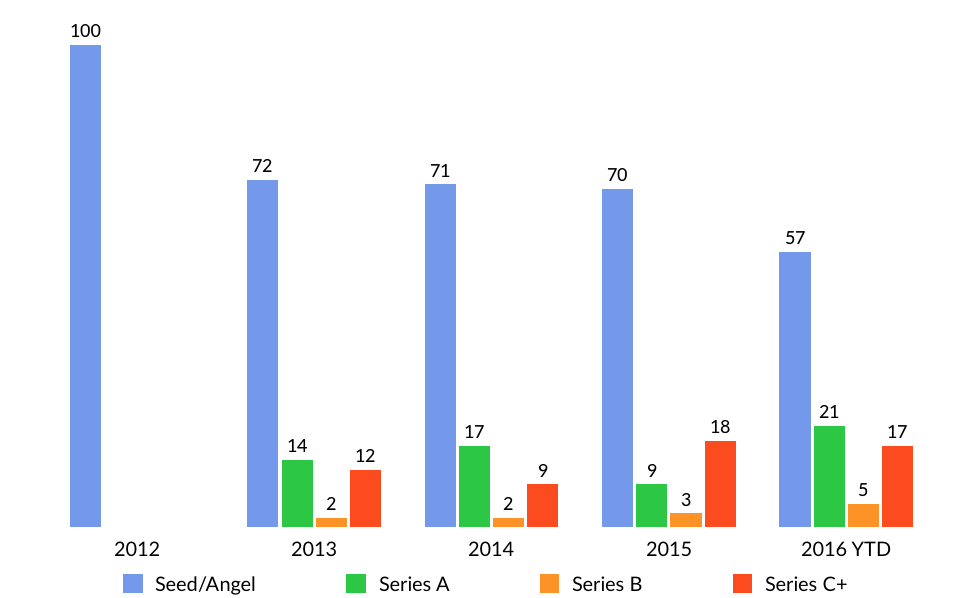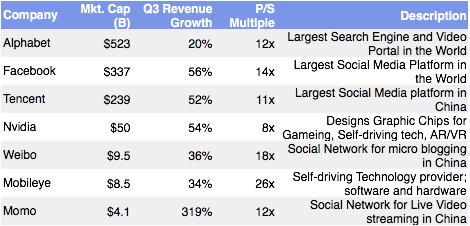Market Snapshot
| Indices | Week | YTD |
|---|
Trust, but verify.
— Ronald Reagan
We’re quite confident that when we’re sitting here in 20 years, we’ll be talking about Bitcoin the way we talk about the Internet today. We just need time for it to play out.
— Marc Andreessen
It wasn’t too long ago that BlackBerry was the coolest technology company in the World. In fact, people were so addicted to their BlackBerries that they were called “Crackberries.”
In 2007, BlackBerry and Apple were both roughly $70 billion market value businesses. Then Apple launched the iPhone. Today, Apple’s value has ballooned to over $580 billion, while BlackBerry has decreased more than 90% to $4 billion.
What happened?
A major part of the story is that Steve Jobs and the Apple TEAM created an insanely great product. The iPhone is a beautiful device with the first viable multi-touch screen interface.
But the critical innovation was Apple’s unprecedented open mobile operating system, iOS, which enabled third-party developers to easily create apps for the device — effectively harnessing the wisdom of crowds to create a rich user experience. Apple created a platform.
Unlike BlackBerry, Apple had an army of outside developers who had already built consumer apps for its computers and iPods and were primed to do the same for the iPhone. By the time BlackBerry launched its first app platform in 2009 — a full two years later — iPhone customers had already downloaded one billion apps.

*As of 11/17/2016
Throughout history, “open systems” have constantly upended “closed systems” by creating superior efficiency, quality, transparency, and access. Free markets outperform rigged models like socialism. Competition drives innovation and better prices. Monopolies create rents.
After the Federal Government made GPS data publicly available in the late 1980s, commercial services built on top of it created an estimated $70 billion in economic value within the United States.
The Internet, in conjunction with the personal computer and then the smartphone, has ushered in an age of decentralized, open information and communication. If you tried to explain it to somebody in the 1960s, where would you begin? At the same time, the word “Internet” has already become arcane. It’s an invisible technology that is as commonplace as breathing.
The launch of Bitcoin in 2009 marked a new frontier for open platforms. At face value, it promises an alternative to one of the World’s quintessentially “closed” platforms — money. Instead of relying on central banks for validity and subjecting people to arcane exchange mechanisms, Bitcoin is an open, electronic, peer-to-peer currency.
While the future of Bitcoin is uncertain — it could be the Facebook or the MySpace of so-called “cryptocurrencies” — the underlying technology powering it, “Blockchain,” is here to stay. Effectively a decentralized, open-source public ledger for the exchange of information, blockchain has the potential to transform any industry that relies on middlemen and “honest brokers” for critical functions — from finance to supply chain management and academic credentialing.
STATE OF PLAY
A New Coin of the Realm
The concept for Bitcoin arrived under the cover of darkness when it was posted to an obscure mailing list by a shadowy author going by the name of Satoshi Nakamoto. Satoshi envisioned a digital analog to old-fashioned gold — a universal currency that could be spent by anyone, anywhere.
Like gold, Bitcoin was designed to be scarce, requiring work to increase circulation. Instead of carving up the earth, Bitcoin required computational “mining” through a complex set of technical protocol.
While bars of gold exist independently of one another, Bitcoin introduced a new wrinkle as observed by Nathaniel Popper in his best-selling book, Digital Gold:
Bitcoins… were designed to live within a cleverly constructed decentralized network, just as all websites in the world exist only within the decentralized network known as the Internet. Like the Internet, the Bitcoin network wasn’t run by some centralized authority. Instead, it was built and sustained by all the people who hooked their computers into it, which anyone in the world could do. With the Internet, what connected everybody was a set of software rules, known as Internet protocol, which governed how information moved around. Bitcoin had its own set of protocol — the rules that dictated how the system worked.
While the complex technical nuances of Bitcoin’s protocol involve advanced math and cryptology, the fundamentals are strikingly clear. It’s a new way to create, store, and send money. And unlike Dollars and Euros, which are created by central banks and managed by complex financial institutions, Bitcoin is created and sustained by its users.
Bitcoin is built on a peer-to-peer technology framework called the “blockchain,” which is the essence of the new currency. The blockchain is a decentralized, public ledger that records information about transactions occurring in real-time. As transactions occur, it forms “blocks” that are linked together through an encrypted mathematical function, thereby forming a chain of records. Presto, “Blockchain.”

A blockchain is a public record that everyone can inspect, but which no single user controls. The participants in a blockchain system collectively keep the ledger up to date by lending their computing power to constantly track new transactions. It is safety in numbers where transactions are processed by everybody and nobody through massive redundancies. In exchange for computing power, network participants receive Bitcoin. Appropriately enough, this process of incentives is called “Mining.”
The net result is a currency without a central bank. It eliminates the middle man.
Today, Bitcoin represents $11.8 billion of market value, versus an estimated $81 trillion of global cash and bank notes. It has been plagued by sharp volatility, which has been exacerbated high profile breaches and the use of the currency to fund illicit activities. But adoption, measured by Bitcoin transactions per day, is exploding. In 2009, the year of its launch, there were an average of 91 Bitcoin transactions per day. In 2016 to date, there have been an average 218,758 transactions per day, representing a 200%+ CAGR over seven years.


A slew of startups has emerged focused squarely on Bitcoin, which generally fall into some combination of three categories: Bitcoin Wallets/Payment Processors like Coinbase, Bitcoin exchanges like bitFlyer, and Bitcoin Mining Platforms like KnCMiner.

Source: GSV Asset Management, CrunchBase, CB Insights, Company Disclosures
Circle, which has raised $136 million since its launch in 2013, is a mobile payments network that lets people send and receive money anywhere in the World for free by harnessing Bitcoin’s blockchain — notable because it is taking advantage of the currency’s architecture more so than the currency itself. Local currency is converted into Bitcoin, transferred from the sender’s Circle account to the recipient, and then converted into the local currency.
Circle’s service is potentially game-changing because it makes exchanging money work like media and messaging in the mobile Internet age: free, global, on-demand, and delightful. Importantly, the fact that transactions are enabled by Bitcoin is incidental to the end user. Senders and recipients can link Visa and MasterCard credit and debit accounts to initiate transactions and receive payments. You don’t need to see the underlying Bitcoin unless you want to.
While mobile payments leaders like Venmo, (PayPal subsidiary that has processed $15 billion year-to-date, growing 130% per year), Alipay (Alibaba spinout with 450+ million users), and Paytm (Indian mobile payment leader, backed by Alibaba and Alipay, with 130+ million users), have gained incredible traction, they do not yet offer seamless, international peer-to-peer payments.
That spells opportunity for Circle, which is an approved payment provider in the United States and Europe. The company recently launched a subsidiary in China, signaling a willingness to partner with Alipay and Tencent’s WeChat (200+ million credit cards linked to the the popular messaging platform’s payment service) to plug Chinese consumers into their global network.
Forbes reports that while Circle does not charge a fee to send money, it captures a small portion of the foreign exchange spread — 0.25% as opposed to 3-4% for bank transfers and roughly 1-2% for newer fintech challengers such TransferWise and Xoom. As it continues to build a defensible international network, Circle will be positioned to offer a broader range of revenue-generating services, from integrated vendor payments to marketplace loans for individuals.
The Power of a Public Ledger
Over the past two decades, the Internet has revolutionized many aspects of business and society, accelerating information exchange, collaboration, and ultimately, innovation. Yet the basic mechanics of how people and organizations execute transactions with one another — from payments to contracts and the exchange of goods and services — have not been updated for the 21st century.
Blockchain technology looks like a breakthrough.

To paraphrase Marc Andreessen, blockchain gives us, for the first time, a way for one Internet user to transfer a unique piece of digital property or information to another Internet user, such that the transfer is guaranteed to be safe and secure. Everyone knows that the transfer has taken place, and nobody can challenge the legitimacy of the transfer.
In other words, Bitcoin is just the beginning. The underlying technology can applied to all manner of “exchanges,” whether or not they’re related to money. The consequences of this breakthrough are hard to overstate.
Here’s Andreessen in a 2014 interview with the Washington Post:
Digital stocks. Digital equities. Digital fundraising for companies. Digital bonds. Digital contracts, digital keys, digital title, who owns what — digital title to your house, to your car. Like for example, you get a digital title on a car, attached to a digital key, where you own your car on the Bitcoin blockchain and on your smartphone. The key for opening your car and starting your car is tied to that title. And if I sell you my car, automatically you get title, and you get the key that lets you operate the car, and it’s all digital, and it’s all unique, and it can’t be cracked. You’ve got digital voting, digital contracts, digital signatures… If we had had this technology 20 years ago, we would’ve built it into the browser.
Today, there’s an emerging belief and a lot of momentum in the idea that blockchain is the next major platform in computing. In the same way that the World went from mainframe to PC to Internet to Mobile — and in recent years, to Augmented and Virtual Reality — blockchain has the potential to be a transformational technology.
BLOCKCHAIN: A NEW COMPUTING PLATFORM

Source: GSV Asset Management
You can already see some of the largest financial and technology companies in the World deploying billions of dollars to understand, integrate, and apply blockchain. Goldman Sachs has patented SETLCoin, a proprietary cryptocurrency that will settle securities trades more efficiently on a blockchain-based platform. The Linux Foundation has joined forces with IBM, JPMorgan, Accenture, Intel, and others to create the “Hyperledger Project,” an open-source attempt to find new use cases for blockchain technology. At the same time, venture capitalists have taken notice, with investment activity accelerating for Bitcoin and blockchain startups.

Financing Activity
Through the end of Q3 2016, blockchain and Bitcoin startups raised nearly $430 million across 92 financings. While deal volume is projected to drop nearly 33% from its 2015 peak of 146, overall funding is projected to increase from $501 million in 2015 to $575+ million in 2016.

Deal activity in 2015 was buoyed by major financings from 21 ($111 million Series C), a secretive machine-to-machine bitcoin payment platform founded by Andreessen Horowitz partner Balaji Srinivasan, Bitcoin wallet and payment platform Coinbase ($75 million Series C), and Circle ($50 million Series C), a mobile payment platform enabling international peer-to-peer money transfers using Bitcoin.
Notable 2016 financings include Japanese Bitcoin exchange bitFlyer ($26 million Series C) and blockchain-enabled smart contracts platform Blockstream ( $55 million Series A), and blockchain-based securities trading platforms Digital Asset ($67million Series A) and Ripple ($55 million Series B). Circle raised an additional $60 million in a Series D financing, close on the heels of its $50 million Series C in 2015.

Reflecting the the early stage of the Bitcoin/blockchain innovation cycle, seed investments have accounted for over 70% of deals per year since 2012. But this trend is changing as the industry matures. Based on the first three quarters of 2016, seed deal share is on pace to fall below 60% by year end.
BLOCKCHAIN BLOCKBUSTERS
A first generation of startups have surfaced that are creating enterprise applications using blockchain technology , which can be applied across a variety of industries. Working with established companies like banks and insurance companies, as well as newcomers, companies like Blockstream, BitFury, and Factom are laying the “digital tracks” that will enable broader application and adoption of the technology.

Ethereum, a non-profit that is creating a blockchain framework intended to be more flexible that the original which was created for Bitcoin, has helped evangelize the technology beyond Bitcoin.
Moving forward, we see six key areas for the emergence of blockchain “blockbusters”.
1. Education & Talent
Abraham Lincoln, perhaps the greatest lawyer in American history, had no formal education. “Sixteen” was self-taught and he passed an examination to practice law in the Illinois Supreme Court by reading borrowed books from a local law firm. Just because Honest Abe didn’t go to a fancy law school did not mean that he lacked outstanding legal skills or that he wasn’t capable of becoming a highly effective lawyer.
Unfortunately, today, the college admissions officer remains the surrogate hiring director for many companies around the World. The college you went to and the degree you received is the proxy for your talents, instead of what you know, what you can do, and how effectively you can do it. But in Silicon Valley, what companies care about is if you have the skills to be effective (Can you code or not? Are you adaptive?), not if you graduated from some prestigious school.

The old ticket to ride was a degree. The new ticket to ride is going to be a Personal Knowledge Portfolio that incorporates content, courses, and experiences, which are curated over time. The fundamental skills of critical thinking, entrepreneurship, quantitative reasoning, and communication are the foundation of an effective Knowledge Portfolio.
Badges and certificates for verifiable skills will play an increasing role in a society that shifts its emphasis from the degree you were granted to the knowledge you possess. While traditional education continues to play a role, it’s about knowledge, not college. What you know, not where you go. We call this trend “Knowledge-as-a-Currency” and it will be accelerated by the application of blockchain technology.
The MIT Digital Certificates Project, under the leadership of Philipp Schmidt, is making this concept a reality. Working with Learning Machine, the initiative is creating Blockcerts, an open infrastructure to create and exchange digital certificates using blockchain. As Schmidt observed in a recent blog post:
In essence, [blockchain] is a just a distributed ledger to record transactions. What makes it special is that it is durable, time-stamped, transparent and decentralized. Those characteristics are equally useful for managing financial transactions as for a system of reputation. In fact, you can think of reputation as a type of currency for social capital, rather than financial capital.
Looking forward, as a generation of lifelong learners increasingly turn to high-quality, lower cost university alternatives — from Coursera to General Assembly, and Pluralsight — blockchain enabled knowledge portfolios will unlock a more transparent, liquid talent pool, to the benefit of all stakeholders. (Disclosure: GSV owns shares in Coursera and General Assembly)
2. Financial Services, Insurance, Contracts
If Bitcoin represents a revolution in money, blockchain could be a revolution in finance. It has the potential to serve as an open platform to move assets and securities. In other words, an industry of middlemen is facing an existential crisis. A distributed ledger will reduce the need and costs for intermediaries focused on trading, cross-border payments, and custodial services, to name a few.
In 2014, not surprisingly, a private consortium of more than 45 institutions, including JPMorgan, Barclays, and Wells Fargo, launched R3 to develop and commercialize blockchain applications for finance. In February the group revealed that it had successfully simulated trades of digital assets on a private network spanning four continents.
Last week, Singapore’s central bank announced that it would begin testing the issuance of digital currency using a blockchain-based interbank payment system — a project supported by R3. The initiative, which also involves the country’s stock exchange and eight banks, is aimed at simplifying the payments process and reducing transaction costs.
Major stock exchanges are also entering the mix. Australia’s ASX announced in August that it expects to have a commercial blockchain platform within 18 months. NASDAQ will deploy a blockchain-based technology for voting and shareholder meetings, as well as a technology that enables private company stock issuance, in 2017.

By extension, blockchain is poised to transform how we think about the exchange of any asset or the creation of contracts. Visa and DocuSign, for example, have announced a partnership to use blockchain technology to streamline car leasing.
Prospective customers will select the car they want to lease and the transaction will be recorded on a blockchain ledger. Customers will then sign a digital lease agreement and an insurance policy, which will be automatically appended to the leasing record on the blockchain.
The same fundamentals can be applied to the Real Estate market. The startup Ubitquity, for example, has created a blockchain-enabled platform to eliminate complex, paper-based transactions by integrating the tracking of land titles, property deeds, and liens into a single record. Safe Share is creating a comparable platform for the insurance industry, reducing processing costs and automating claims management with trigger-based payments.
3. Healthcare
Healthcare institutions suffer from an endemic inability to securely and efficiently share information, despite the profound opportunity to benefit consumers. A central challenge has been the absence of a shared communication network that both meets the needs of all parties without compromising patient information security. The net result has been a tangled network of redundant, error-prone records.
Blockchain technology has the potential to enable better data collaboration between providers, patients, and insurance companies, which would translate into higher probabilities of accurate diagnoses, increased likelihood of effective treatments, and reduced costs for all parties.

Gem, for example, recently launched the Gem Health Network in partnership with Philips. It’s an Ethereum-enabled blockchain network streamlining data movement and integration from patient records, wellness apps, insurance claims management, clinical and trials.
In 2016, the government of Estonia announced that it would begin securing over a million healthcare records using blockchain in partnership with Guardtime and Oracle. It’s the first national health system to adopt the technology.
4. Digital Media
In 1999, Napster launched a peer-to-peer network that enabled users to share millions of music tracks for free. Unfortunately for consumers, the service violated just about every intellectual property law that it touched and was quickly shut down. But despite its early demise, Napster marked the crossing of a Rubicon for digital content in the Internet age.
For consumers, there was no going back to the old-fashioned way of buying a whole album. Napster presaged the rise of streaming platforms like iTunes, Pandora, and eventually Spotify (Disclosure: GSV owns shares in Spotify).
For artists, it underscored how powerful the Internet could be as a distribution channel for music. But the arcane rules and processes governing content rights and the role of middlemen like record labels have only evolved incrementally, despite the rise of powerful new consumer channels.

A blockchain framework could be applied to associate music, or any other form of digital content, with its creators. Each unit of content — whether an article, photograph, or a song — could be embedded with a “smart contract,” governing licensing rights, distribution rules, and pricing.
Mycelia, for example, founded by Grammy-winning artist Imogen Heap, develops intelligent songs with with embedded licensing rules. Each song is effectively a blockchain enabled contract that let artists to sell directly to fans without going through a record label. Ujo is creating a network of musicians using Ethereum’s blockchain platform to allow musicians and other artists to record and publish rules on how they want their songs to be used. It’s a 21st century music catalog.
As blockchain applications continue to mature, it will adoption by content creators of all stripes, from journalists to photographers and visual designers.
5. Supply Chain Management
At its core, a supply chain is a series of transactions that move products from a point of origin to a point of sale or deployment. While the World’s top manufactures, from Apple to Boeing, have developed competitive advantages through complex, proprietary global supply chains, tracing the origin and movement of products, and paying for them, remains inefficient and error-prone.
Blockchain can optimize supply chains by creating a secure, common record for all key participants to track the origin and movement of goods — from raw materials to components and manufactured end products. Transparency creates efficiencies for all participants, enabling quicker adjustments, more accurate forecasting, and targeted forensics in the case of recalls.

This year, mining giant BHP Billiton announced that it in 2017, it will begin using blockchain to manage rock and fluid samples from its vendor network — a key input that guides where the company creates mines and oil wells. Instead of continuing to rely on emails and spreadsheets, BHP is partnering with blockchain startups BlockApps and Consensys to create a transparent ledger where technicians taking specimens can attach data (e.g. collection time and conditions) and lab researchers can add detailed reports. All will be immediately visible to anyone with the appropriate access.
IBM handles millions transactions per year, from its own vendor purchases to financing purchases for clients. Disputes, which take 44 days to resolve on average, typically arise over tax rates and missing or incorrect shipments. In September it began using a blockchain ledger that has reduced dispute resolution time to ten days on average.
Startups like Skuchain and Hijro are focusing on supply chain finance — a $2+ trillion market where suppliers borrow against expected receivables from major retailers like Walmart, which often push out their payments by 40 days or more. Financiers have traditionally offered suppliers who are eager to be paid right away the equivalent of payday loans, charging 5-10% for their services. But blockchain can create transparency around the process, providing better visibility into the status of receivables, enabling lenders to offer more competitive rates. This, in turn, enables suppliers to lower prices, as they are no longer burdened by unreasonable borrowing terms.
6. Internet of Things (IoT)
Adding Internet connectivity to everything multiplies vulnerabilities. IoT devices effectively enable sophisticated attackers to move laterally across a centralized network after they gain an entry point. In other words, hackers can infiltrate one device and start probing an entire system until they find a high-value database of personal information or a repository of sensitive business data.
At the core of this challenge is the fact that the proliferation of Internet-connected devices has been fueled by the availability of low-cost, mass-produced semi-conductors which can be embedded in anything. According to Gartner, by 2020, there will be more than 20 billion connected things across the globe. The widespread availability and proliferation of these devices means that once a device is compromised, it’s very difficult for a company to flip a switch and correct the problem.
Blockchain technology can lead to the creation of secure connected networks, where IoT devices can interconnect in a reliable way while avoiding security threats. Every device can be registered on the blockchain, with each linked device being able to authenticate each other without a for centralized certification. In this framework, it would be harder for hackers to move laterally after infiltrating one device.
Companies are already levering the power of blockchain to power IoT networks. For example, Filament uses blockchain technology to power a network of IoT products for the agriculture, manufacturing and oil industry. Telstra, an Australian telecom giant, secures smart home IoT systems using blockchain technology.
IBM and Samsung created a decentralized IoT system called ADEPT, which stands for Automated Decentralized P2P Telemetry. This initiative creates a blockchain that serves as a public ledger and backbone for billions of IoT devices, removing the need for a central control hub to mediate communication between such devices. This then enables these devices to communicate with one another autonomously to broadcast transactions between peers, manage software updates, and perform self maintenance.
WHAT’S NEXT
It’s still early days for Blockchain, and it will continue to be refined — particularly in the wake of security breaches like the recent $64 million hack of Ethereum.
But blockchain technology is poised to impact anybody in the “trust business” — centralized institutions and bureaucracies, from banks, to clearing houses and government authorities that create bottlenecks because they are “trustworthy” enough to handle transactions.
That spells major opportunity for entrepreneurs and we’re excited to see the emerging “Stars of Tomorrow” who are building great businesses with blockchain.
—
Stocks continued to fly as bond yields and the Dollar also rose for the week. NASDAQ, recovering from it’s Trump induced hangover, was up 1.6%, the S&P 500 rose 0.8%. The small cap focused Russell 2000 has had eleven sessions in a row of gains, finishing last week up 2.6%. The growth focused GSV 300 was down 0.9% last week.

The once weak dollar rose 2.2% last week against the EUR and is now at the highest level since 2003. The 10-Year Note yield rose 20 bips to 2.34% as Fed Chairwoman Yellin said rates are heading higher… and this time, she really means it. A whopping $31 bilion flowing into equities last weekend.
Salesforce reminded the Market that it is still King of the software-as-a-service universe, putting up 25% revenue growth for the third quarter. Tencent continued to roll and posted 52% revenue growth for the quarter. The biggest buzz was around Snap, the parent of the social broadcasting app for the Millennials, Snapchat. Multiple sources reported that the Company had done a quiet filing to go public. (Disclosure: GSV owns shares in Snap)
We continue to like the positive fundamentals and corresponding stock action in the best growth companies. Accordingly, we remain BULLISH.









